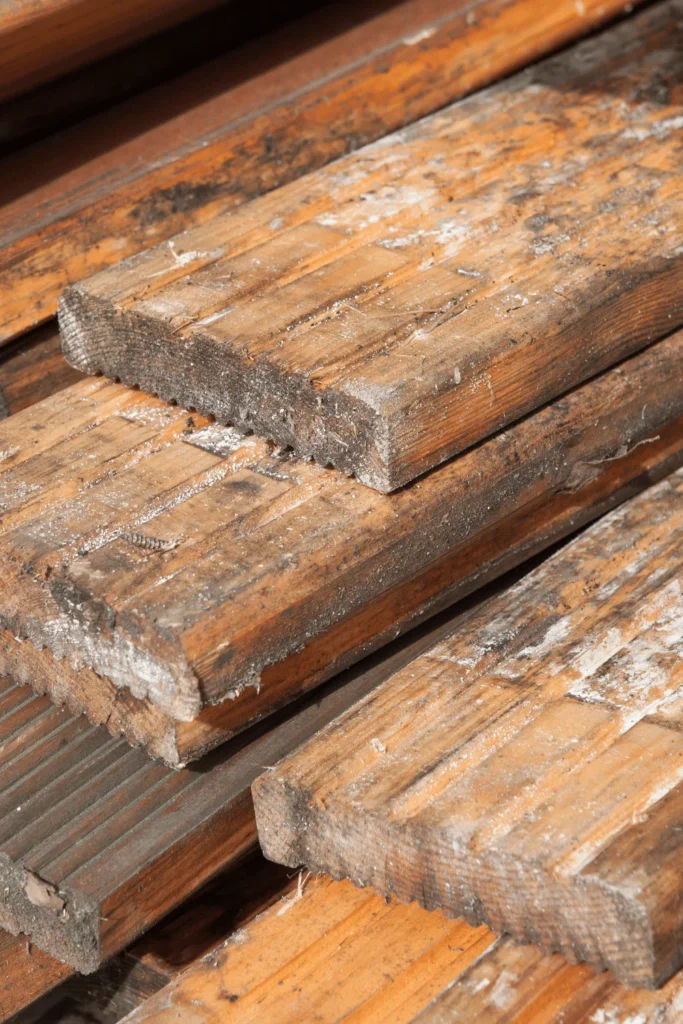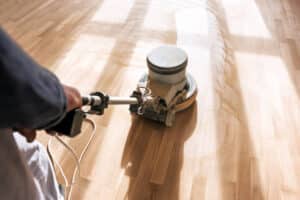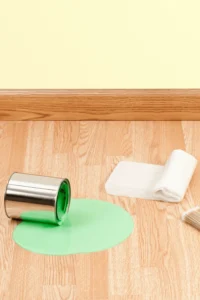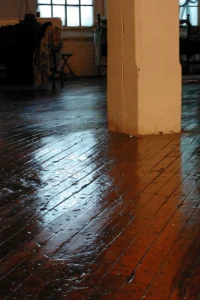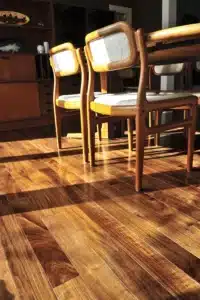Discovering signs of mold under hardwood floors can be a homeowner’s worst nightmare.
Mold not only damages the aesthetic appeal of your beautiful floors but can also pose serious health risks to you and your family. That’s why it’s important to identify and address this issue promptly to maintain the integrity of your home and ensure the well-being of your family.
Let’s walk you through how to recognize the signs of mold on your hardwood floor, how to tell if there’s mold in your home, and solutions to get rid of it (for good!).
What Does Mold Look Like on Hardwood Floors?
Mold on hardwood floors can manifest in a few different ways. That means it’s more important than ever to know the various signs of hardwood floor mold. Here are some common indicators and signs of mold under your hardwood floors:
- There are dark patches or streaks along your wood. These will likely be an irregular shape, and could spread over time if it’s left untreated. That’s why if you see these in your home, measure them and track if they’re getting larger.
- There’s a fuzzy or slimy texture: This is a clear sign of mold growth, and a result of the mold colony expanding, feeling slightly raised or bumpy to the touch.
- There’s been an unusual color change on your hardwood floors. Mold isn’t limited to just black or green; it can come in a range of colors, including white, gray, or even yellow. Pay attention to any unusual color changes on your hardwood floors, as they may indicate mold presence.
- There are stain or spot growth patterns. Mold tends to grow in patterns, sometimes resembling stains or spots. It can spread across the floor and even between the planks, which might make it hard to see at first if you don’t inspect your wood floors regularly.
It’s important to keep an eye out for these signs so you can catch mold as early as possible. Otherwise, the mold could cause hardwood floor damage.
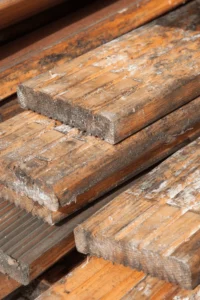
What Causes Mold on Hardwood Floor?
Though it might seem like it, mold under hardwood floors isn’t a random occurrence.
It’s usually the result of specific environmental conditions in your home, whether before you moved in or after. Let’s break some of these conditions down so you can track down a potential culprit (and know how to prevent mold growth in the future).
Higher Home Humidity
Mold loves moisture, and high humidity levels in your home create the perfect environment for it to thrive. When the air in your home is too humid, it increases the moisture content on surfaces, including hardwood floors. This creates an ideal breeding ground for mold.
To keep mold at bay, maintain indoor humidity levels between 30-50%. This range helps ensure that your home’s environment is not conducive to mold growth.
Use dehumidifiers, and air conditioners to significantly help in controlling indoor humidity. These remove excess moisture from the air, reducing the likelihood of mold development on your hardwood floors.
Water Damage
Water damage is another common culprit behind mold growth on hardwood floors.
Think of any leaks you may have had from plumbing, appliances, or roofs, as well as spills that are not promptly cleaned up. These can all lead to water seeping into your hardwood floors, creating an ideal environment for mold to grow.
The longer this water sits, the higher the chance of mold developing. If you think or know you have sitting water somewhere, the time is now to get a hardwood floor specialist to help you.
To prevent this from happening in the future, regularly inspect your home for leaks and promptly repairing any issues can prevent water from damaging your hardwood floors and, subsequently, prevent mold growth.
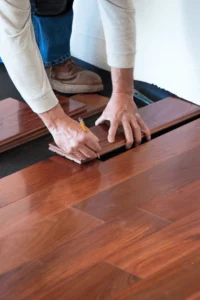
Signs Of Mold Under Your Hardwood Floor
Identifying mold under your hardwood floors can be challenging, as it’s often hidden from view. However, there are telltale signs that can alert you to its presence.
There’s a Musty, Moldy Smell
One of the most common indicators of mold growth is a distinctive musty odor.
If you’ve noticed a persistent musty smell in your home, it could be a sign that mold is growing beneath your hardwood floors. This odor is often described as earthy or damp and can be more noticeable in certain areas.
Trust your sense of smell to detect moldy odors, especially in rooms where water damage has occurred or in areas with high humidity. Pay attention to any changes in the smell of your home, as this could indicate the presence of mold.
Don’t second-guess yourself— reach out to a hardwood floor specialist so they can take a closer look. You’re better safe than sorry.
You See Black Spots
Another clear sign of mold under your hardwood floors is the appearance of black spots.
Black spots on the surface of your hardwood floors or between the planks are often a telltale sign of mold growth. These spots can vary in size and may spread if left untreated.
Pay close attention to areas where water may have seeped in, such as near doorways, windows, or plumbing fixtures. These are common entry points for moisture, which can lead to mold formation.
It might be hard for you to notice black spots if you don’t look closely at your hardwood flooring.
Take time every month or so to do a quick check over your hardwood floors. Get familiar with the different wood patterns so you can see if anything has changed.
Your Home’s Humidity Levels Are High
As we mentioned, high humidity levels in your home can indicate the potential for mold growth under your hardwood floors.
If you don’t have one already, getting a hygrometer to monitor the humidity levels in your home is an effective way to keep track of potential mold risks. If you notice that the humidity levels are consistently above the recommended range of 30-50%, it’s time to take action by using dehumidifiers or adjusting your HVAC settings to reduce moisture in the air.
This is especially common if you live in more humid climates.
Your Wood is Discoloring, Peeling, Warping or Buckling
Visible changes in the appearance and texture of your hardwood floors can be a sign of underlying issues, including mold growth.
Discoloration, peeling, warping, or buckling of your hardwood floors can indicate water damage, which often precedes mold growth. These changes can occur when moisture seeps into the wood, causing it to expand or contract.
This will probably be a little easier to notice than small discolorations— so pay special attention to areas near water sources or in rooms with high humidity levels.
If you’re noticing any signs that your wood flooring isn’t acting the way it should, it’s time to investigate further to determine the cause.
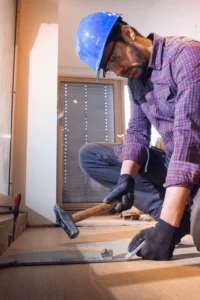
You And/Or Your Family Has Developed Allergy-Like Symptoms
It’s scary to think about how much mold could damage you and your family’s health. On a minor level, mold could cause allergic reaction-type symptoms, and on a major level, it could be much worse.
Think about if you or your family members start experiencing allergy-like symptoms like coughing, sneezing, itchy eyes, or respiratory issues, it could be a sign of mold exposure.
These symptoms may be more pronounced when spending time at home.
If you notice a correlation between these symptoms and your time spent at home, consult a healthcare professional immediately. They can help determine if mold exposure is the cause and provide guidance on how to address the issue.
How to Prevent Hardwood Floor Mold
Preventing mold growth on your hardwood floors is crucial for maintaining a healthy and beautiful home. Let’s tie up some of what we learned into some simple and easy points to remember:
- Maintain proper humidity levels of 30-50%. Use dehumidifiers, air conditioners, and exhaust fans to regulate moisture in the air and prevent the conditions that allow mold to thrive. You can also consider getting an air purifier to detect when air quality is being compromised and purify it to the best of its ability. (Please note that this isn’t a replacement for getting your mold remediated!)
- Regularly clean and dry your floors. Spills and moisture should be cleaned up immediately to prevent water from seeping into the wood. Regularly sweep, vacuum, and mop your hardwood floors to keep them dry and clean.
- Seal your hardwood floors: Applying a sealant to your hardwood floors can create a barrier that protects against moisture penetration. Make sure to choose a sealant that’s appropriate for your type of hardwood and follow the manufacturer’s instructions for application and maintenance.
- Inspect and repair leaks: Regularly check your home for any signs of leaks or water damage, especially in areas prone to moisture such as bathrooms, kitchens, and basements. Promptly repairing any leaks can prevent water from reaching your hardwood floors and causing mold growth.
TriArt Hardwood Floors Can Help You Identify and Alleviate Mold Under Your Hardwood Floor!
By knowing the signs of mold under hardwood floors, you’re one step closer to taking better care of your home flooring. We know how to remove mold from hardwood floors and can help you with the next steps you need to take.
We’re excited to help you ensure your floors remain a beautiful (and healthy!) part of your home.

